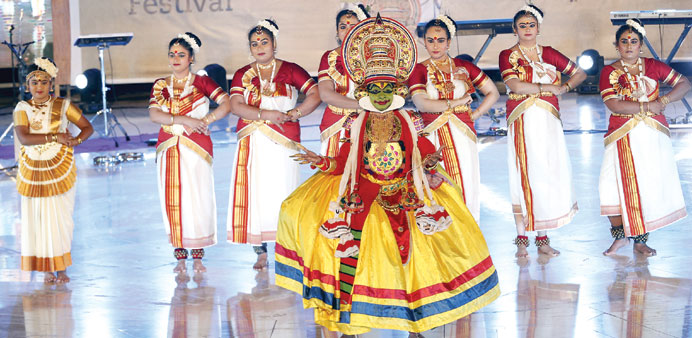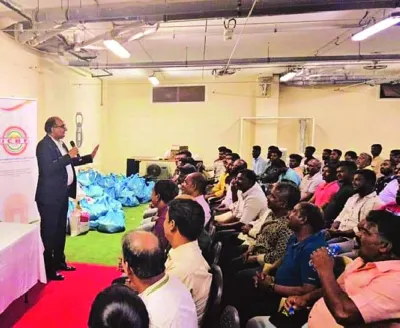COLOURS OF INDIA: Dancers perform Kathakali, a dance form from the southern state of Kerala, at the Indian Festival in Katara last week. Photo: Jayaram
By Anand Holla
One would be hard-pressed to pick just one favourite bit from A Passage to India, the two-day Indian cultural festival that swept Katara in style, last weekend. Featuring a non-stop flow of dance and music performances, the choicest art and handicrafts and lip-smacking cuisines from various states of India, the colourful fiesta, organised by the Indian Cultural Centre (ICC) in association with Katara, brought out a sizeable enthusiastic bunch from the 500,000-strong Indian community in Qatar.
Community spoke to ICC President Girish Kumar about the second edition of this festival – the first held at the Museum of Islamic Art Park in November 2012 drew more than 25,000 visitors – and what went into putting it together.
How successful was the festival and what were its highlights?
It was very successful indeed. The continuous on-stage performances that kept going without any time lag despite the programme involving more than 500 performances has to be our greatest achievement. The audience waited till the very last performance on the both the days – at 10pm – and it ended with a message of Indo-Qatar friendship that was lauded by all.
The highlights were many. Indian dance features diverse folk and classical forms. Among the better-known folk dances are Punjab’s Bhangra, Assam’s Bihu, Chhau of Odisha, West Bengal and Jharkhand, Garba and Dandiya of Gujarat, and the Lavani of Maharashtra. All major classical dance forms; Kathak, Odissi, Bharatanatyam, Mohiniyattam, and Kuchipudi, were included in the programme and were greatly applauded by the capacity crowd that had filled the Katara amphitheatre.
What is the best feedback you received on the event?
The most heartening feedback came not just from various Indian communities, but also from people of various countries. Some suggested that we should have this kind of programme more than once a year. Through the spectacular, multi-hued performances, the artistes could touch the soul of the audience, once again proving that performing arts know no boundary. For instance, the opening fusion dance of the event – a combination of Bharatanatyam, Odissi and Kathak by three talented teachers, led by ICC dance teacher Shaily Chatterjee – earned the admiration of many. One Western diplomat expressed her wish to dance with them.
The 10 metre-high replica of the India Gate at the entrance of the festival venue drew a lot of curiosity and praise. What was the idea behind replicating this monument for the festival?
India Gate is almost synonymous to the country, an important monument that stands in India’s capital New Delhi. In the words of then Viceroy Chelmsford, “The stirring tales of individual heroism will live forever in the annals of the country,” and the war memorial – a tribute to the memory of our heroes, “known and unknown” – would inspire future generations to endure hardships with similar fortitude and “no less valour.”
The Memorial Archway was designed to keep in the thoughts of future generations “the glorious sacrifice of the officers and men of the Indian Army who fought and fell”. There are quite a number of Indians, both young and old, that I have met abroad who were not even aware of the history of India Gate.
This inspired me even more to embrace my patriotism. History tells us that it was built in commemoration of more than 90,000 soldiers killed during WWI. So we had the India Gate replica built to symbolise the nation, to mark the entry to the festival, and to inspire overseas Indians, families and children to pay tribute to the heroes who sacrificed their lives. Even on a joyous occasion as this festival, we shouldn’t forget them.
The wooden replica is said to have taken around 50 hours to build. Who are the people behind Viswakalavedi that built this installation?
Viswakalavedi is one of the several socio-cultural organisations affiliated to ICC. Following are the people who created the replica: Sajeevan A, Aneesh Kumar T, Subhash TV, Sunil Mathoor, Renjith, Gireesh Kumar KP, Mohanan M, Sivadasan D, Renjith KP, Subin Prakash, Vadanesh E, Pradeep T, Prasad PV, Sunil Kumar Kackovil, Sudheer KP, Shaji CK, Abhilash, Vinayan, Unni K, Premjith T, Arun PV, Anil Mathoor, Manoj Kumar PV, Rineesh, and Rajesh CK. All are from Kerala. It was a real challenge for them as they are a small group tasked with such big work. But their hard work paid off.
How challenging was it to showcase a glimpse of the multi-faceted Indian culture in just two days?
Indian culture, often termed as an amalgamation of several cultures, spans across the Indian subcontinent and has been influenced by a history that’s several millennia old. A country with 29 states, seven union territories and a 1.2bn population, it is the world’s second most populous country.
The objective was to get together and share the wealth of India’s vibrant cultures, to embrace differences that make our country unique and to discover similarities that unite people regardless of their origin. The Embassy of India – Indian Cultural Centre has 93 affiliated organisations and several Indian schools under its umbrella, intended to provide a platform to come together on the world-class amphitheatre of Katara to present India’s great cultural diversity to a multi-lingual, multi-cultural audience of Qatar.



